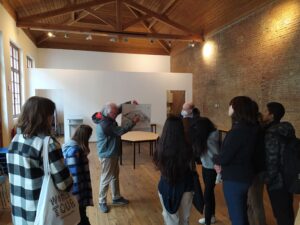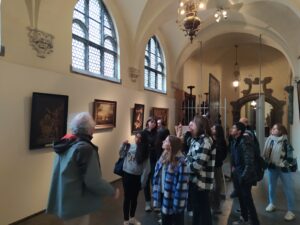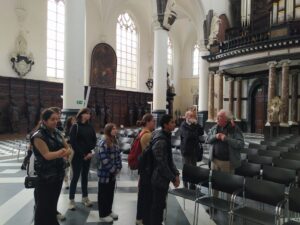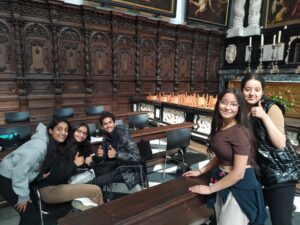On the occasion of Heritage Day 2022, 5ECMTb-LMT was able to spend an entire afternoon exploring the site of St Paul’s Church on Friday 29 April 2022. This historic church is located in the old city centre, a stone’s throw from the river Scheldt, in the city quarter where sailors used to live. Therefore, it goes without saying that this church has served as the port’s parish church for centuries. All boatmen, sailors, dock workers… came to pray for prosperity in this church, even during Jakob Fugger’s lifetime.

The present building dates from 1571. It was built on the foundations of the previous church, which was known to Fugger.
In 1262, the Dominicans have a first church built. None other than the famous Albertus Magnus consecrates it. Because the Scheldt has been flowing faster into the North Sea since the Sint-Elisabeth floods of 1421-1423, low-lying Antwerp suffers flooding. The Dominican church, too, gets waterlogged. The only solution appears to be to heighten the terrain on the convent property and the streets around it. A more spectacular incident is caused by fire. On 6 July 1477, a lightning strike strikes the altar of St Dominicus, the founder of the order, throwing his statue off the altar steps.

During the rise of Antwerp’s Golden Age, the Dominicans decide to have a new, larger Gothic church built around 1512. To solve the problem of rising water for good, in anticipation of the new church, the entire building site around the existing church is raised to an embankment 1.60m above the current street level. Since then, the street level at the side gate of the Veemarkt has risen by a total of about 70 centimetres.

On a guided tour, we visited the crypt and could actually see that the original church and entrance were 3.70 metres deeper than it is today. Through an iron gate by the artist Bruno Kristo, we literally stepped into the 13th-century church and its cloister just like Jakob Fugger did. We saw both walls of the first high choir, which are more than 750 years old. Through a first portal, we entered the 13th-century monastery. This portal in brick masonry, plastered and painted in wide bands of white and black (as an imitation of natural stone) and red brick painting is unique, as you won’t find it anywhere else in Antwerp. A little further on, just before the entrance to the chapter house, we saw impressive fragments of the monumental monastery gate from the same period. Slender columns are supported by natural stone blocks. We also saw the oldest bricks in Antwerp: large stones of up to 30cm long in a wall fragment from around 1320.

The old site must already have been an intriguing place that captured the imagination, but when we emerged from the basement and had the current church in brilliant light in all its glory before us alone, we were stunned. We admired Antwerp’s oldest organ (an immense instrument for its time with more than 3,000 pipes), tried to figure out the symbolism of soap bubble blowing, found a 17th-century heating system in a confessional and enjoyed the wonderful collection of paintings this church has. By the way, did you know that this is the only place in the world, where works by Rubens, Van Dijck and Jordaens have hung side by side unchanged over the centuries?

